The summer picnic is a much anticipated event on every Italian’s culinary calendar, so Mario Matassa shows us how to prepare for the occasion in style
Picnic food photos by Mario Matassa
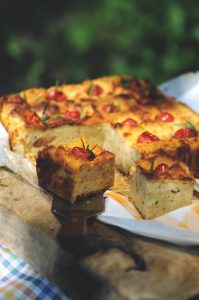
First, the picnic needs to be distinguished from the pranzo al sacco (packed lunch). The packed lunch is what Italians do when they are going hiking or cycling in the country, the meal being of secondary importance to the physical activity. A picnic is a much weightier affair. If you want to have an Italian picnic, you first have to familiarise yourself with the picnic code.
To begin with, you must travel in convoy. Two cars is the absolute minimum, and these should be packed to capacity with screaming adults and their patient children, and enough food to feed everyone for a week. The boot of your car must also be stuffed with any equipment you might ever consider that you might possibly find useful. This equipment will vary according to the kind of picnic you want to have. There are three types: the Sunday lunch picnic, the barbecue picnic, and the deceptively named no-cook picnic.
The Sunday picnic, as the name implies, is Sunday lunch outdoors. This was one of my first experiences of picnicking Italian-style, and the memories have stuck with me. I remember Giuseppe handing me a wedge of Parmesan and a grater as he emptied a packet of spaghetti into a 15-litre cauldron of boiling water while Carla spooned tomato sauce, meatballs and sausage from a tupperware container into a large saucepan. Somehow pasta takes on a completely different flavour when eaten outdoors in a beautiful setting…
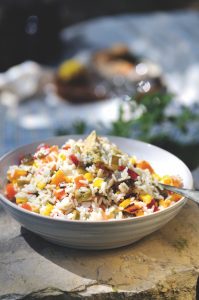
For many Italians, barbecues and picnics are virtually synonymous. On a hot summer’s day one year, my wife’s cousin Adriano suggested a mountain picnic to escape the heat. It seemed a sensible idea. The drive itself – under an hour – wasn’t too arduous compared to the 30-minute hike to the stream carrying, amongst other things, two sets of tables and chairs, a 12kg watermelon, a crate of assorted bottles, two refrigerator boxes packed to the brim with ribs and chicken, not to mention the impossibly heavy 15kg barbecue! If an Italian tells you he’s packed the ‘kitchen sink’, assume he’s not being metaphorical.
Then, finally, there’s the no-cook picnic. This picnic was designed to take all the stress out of picnicking on the day. (What everyone fails to mention is the 24 hours of cooking it entails beforehand.) The no-cook picnic tends to be a leisurely affair, the meal sometimes lasting from lunch into early evening. Several years back I went on a no-cook picnic in the mountains above Lake Como. There were around 20 families, with everyone bringing a selection of their signature dishes. To any foreigner looking on, it must have been a spectacle: 100-odd Italians sitting on a picnic blanket tucking into a feast on the side of a mountain. But to any Italian it would have looked perfectly normal.
Food for a picnic
Bread cake
This dish, or a variation of this dish (of which there are a great many), is a legacy of good old Italian cucina povera (peasant cuisine). The idea is that nothing should go to waste, and this bread cake is an economical – and tasty – way to use up leftover bread. It’s also seems somewhat unusual as you are using leftover bread to make bread!
Both savoury and sweet versions of bread cake can be made and though the idea may seem essentially Tuscan, they are popular throughout Italy. The variations are endless. As far as savoury is concerned, you can use any combination of semi-hard grated cheeses along with fresh herbs, olives, and even throw chopped pancetta, ham, or pieces of salami into the mix. For a sweet version, follow the same process of soaking the bread and adding eggs, then add sugar and a combination of dried fruit, nuts and chocolate chunks. Make a torta di pane e pomodorini with this recipe.
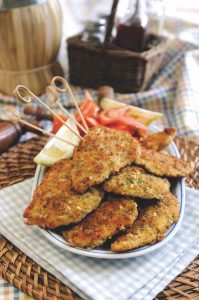
The escalope
The breaded escalope has obvious similarities with, but is not to be confused with, the cotoletta (or costoletta) – the differentiating factor is the bone. Escalopes are thinly sliced pieces of meat off the bone of most often, but not always, veal. They’re a mainstay of Italian cuisine. As Italians generally eat several courses, meat rarely constitutes the focal point of a meal. Escalopes are perfect in that, as they are thinly sliced, they are light enough to follow on from what’s generally the more substantial course, the primo.
There are endless variations on breading an escalope and it’s worth experimenting. A little cheese gives the crumb a punchier flavour and practically any mature cheese that can be finely grated, such as Parmesan, will work. In this recipe I’ve also used fresh parsley, but you could also use any number of herbs, such as mint, thyme or marjoram, as well as a grating of lemon zest. Freshly grated breadcrumbs, needless to say, are preferable to the shop-bought variety. It’s another classic way to use up leftover bread and they also lend a more rustic finish to the escalope. Here’s a great recipe to try for your own picnic (pictured above).
The panino
Italians, it has to be said, are incredibly unimaginative when it comes to their panini. I suspect it’s because sandwiches have never really been considered a viable alternative to a traditional lunch – more a necessity when there’s no other option. When you go into a bar in Italy, don’t be surprised if your choice of sandwich filling stretches no further than a range of sliced salumi (cured meats), or mozzarella and tomato. But with so many meats, bread varieties, and vegetables to hand, Italians are missing a trick. This sandwich is the perfect picnic food. Alternatively, grill the vegetables in the dying embers of your next barbecue, wrap between slices of focaccia, and you have the perfect lunch for the next day! Try this Mediterranean sandwich for a real taste of Italy in summertime.
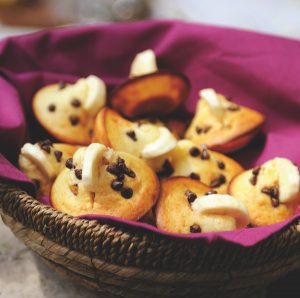 Muffins
Muffins
There’s no translation for ‘muffin’ in Italian. It’s one of those things that Italy, along with the rest of the world, has accepted from across the Atlantic with a quiet nod of gratitude. Unlike in the UK, huge muffins packed with a combination of dried fruit or chocolate chip are not something you will often see in coffee bars. Muffins tend to be something made as a treat for children. Alternatively, they make for excellent picnic food – and not just for the children! These chocolate chip and banana mini yogurt muffins (left) are a real treat.
Rice and pasta salad
Every Italian has an opinion about what makes a good rice salad. Some will tell you to throw a cup of cold water into the rice the moment you turn off the heat, then drain and rinse under cold water to stop it cooking. The same goes for pasta. Also, don’t use risotto rice for this – it’s too sticky. In Italy we use a rice labelled ‘parboiled’, but American long-grained rice is equally suited. Whatever’s to hand can be chopped up and thrown into the salad in quantities to match your taste. There are no hard and fast rules – tuna and salmon work well, as do frankfurters, cooked and sliced. Click here for a simple but tasty rice salad recipe.
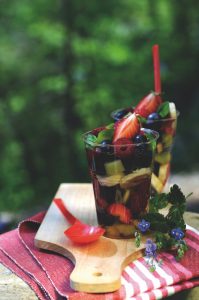
Fruit salad
Italians almost always end a meal with fruit. Desserts tend to be saved for special occasions. Normally for a picnic, the custom is to bring a piece of fruit, often a watermelon, which is left to cool in the waters of a stream along with a couple of bottles of wine. That said, Italians love their macedonia (fruit salad), and so, in my opinion, this dish satisfies both the healthy custom of finishing a meal with fruit and that sense of special occasion Italians get when they eat a dessert. While usually associated with savoury dishes, many herbs also work well in sweet. Sweet basil-infused syrup goes perfectly with fruit, as does mint. Other combinations that I’ve found include lemon and basil, and lime and mint. Whichever you opt for, make sure the syrup is properly chilled well in advance. This mixed fruit salad with basil syrup (right) is a delight.
For more features on Italian food (and delicious recipes), check out our archive
